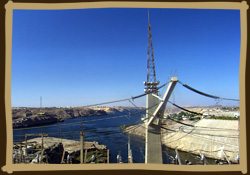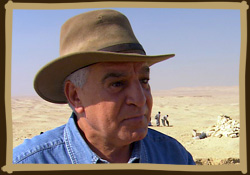
Ecological issues: Two challenges facing Egypt
Preservation of Egyptian Monuments
 Many of the ancient monuments are disappearing before our eyes. The dam at Aswan saved Egypt from the terrible drought of the 1980s that devastated Ethiopia. The high dam allowed Egyptians to grow three rounds of crops each year and hundreds of tour boats to cruise the river every year. Yet the dam is also wreaking ruin on the monuments, these magnificent ledgers of the past. Without the floods and silt of a free flowing Nile, the salt levels along the banks have increased. The porous rock of the temples soaks in the salt, destroying the stone. When the Nile used to flood the banks, it removed the salts in the soil. After the Aswan dam was built, the natural drainage of the Nile has been blocked.
Many of the ancient monuments are disappearing before our eyes. The dam at Aswan saved Egypt from the terrible drought of the 1980s that devastated Ethiopia. The high dam allowed Egyptians to grow three rounds of crops each year and hundreds of tour boats to cruise the river every year. Yet the dam is also wreaking ruin on the monuments, these magnificent ledgers of the past. Without the floods and silt of a free flowing Nile, the salt levels along the banks have increased. The porous rock of the temples soaks in the salt, destroying the stone. When the Nile used to flood the banks, it removed the salts in the soil. After the Aswan dam was built, the natural drainage of the Nile has been blocked.
Tourism also takes a big toll. The humidity from the breath of millions of tourists is also precipitating irreparable damage. Dr Hawass, Secretary General of the Supreme Council of Antiquities, writes on balancing tourism and preservation of the monuments.

Rotating Open Sites
"Balancing tourism and the preservations of the monuments is very important. One of the things I am most proud of in my career is the site management project in Giza. It has many aspects and I plan to implement them at all the historical sites in Egypt. For example, a rotation system, having one pyramid closed for cleaning and restoration and two pyramids open to the public. Each year a different pyramid would be closed. Also rotate the tombs that are open to the public."Restricting numbers
"We have restricted the number of people that can enter the Great Pyramid to 150 a day to keep the moisture and other eroding factors under control. Also, we have just completed a new entrance to the pyramid area and we are working on stopping all vehicle traffic. We will have an information center and electric cars that transport the tourist."New Sites and hours
"We are opening new sites. And we have opened more tombs at the most popular sites We have extended the hours the Egyptian Museum is open. Until recently it closed at 4:30 and now it is open until 7pm. This will stop the rush and keep the crowds under control."New Excavations limited
"I have also decided that no mission will be granted permission for new excavation projects from Giza to Abu Simbel. Teams will only be granted permission to do survey, restoration, GIS, and site management work. However, I will give permission for new excavation in the Delta and the desert."For more information: Dr. Zahi Hawass
Learn More about damage to the monuments
Join an archeology expedition and make a difference.
Check under "fieldwork" to investigate upcoming digs and how to join.
![]()
The Plight of the Egyptian Crocodile
 Once the top predator, the crocodile kept the fish population in balance and served as the Nile custodian, cleaning up carcasses from the river. When crocodiles flourished here, they did so in fearsome numbers. About 300 B.C., when the army of Perdiccas was crossing the Nile at Memphis, the soldiers forgot to pay their proper respect to Sobek and hundreds were killed and eaten.
Once the top predator, the crocodile kept the fish population in balance and served as the Nile custodian, cleaning up carcasses from the river. When crocodiles flourished here, they did so in fearsome numbers. About 300 B.C., when the army of Perdiccas was crossing the Nile at Memphis, the soldiers forgot to pay their proper respect to Sobek and hundreds were killed and eaten.
As the population grew along the river, the Lord of the Nile slowly disappeared from the Egyptian Nile. Hunting, pollution and the Aswan dam robbed the river altogether of its ancient consort. In the 1950s, big game hunters flocked to Egypt to hunt crocodiles, decimating the population. But today, concern for preserving the Nile is taking hold and the hunting of crocodiles is illegal. Today there are reports that crocodiles are making a miraculous return in the south of Egypt in Lake Nasser.
Facts about the Nile Crocodile
Wild Egypt - The Nile Adventure
![]()
![]()
HOW TO HELP
World WideLife Fund
click on adoptions, then crocodile
